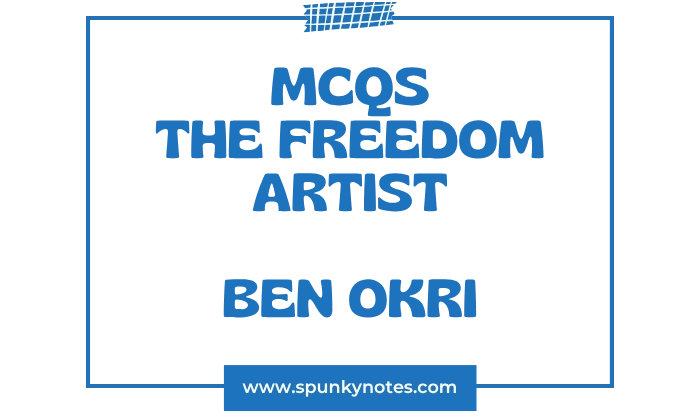

Estimated Reading Time: 17 min
The Freedom Artist MCQs
1. What was the name of the boy reading to the old man in the yellow house?
A. Karnak
B. Jim
C. Mirababa
D. Lao
2. What did the old man’s silence teach Mirababa about questions?
A. They must never be asked.
B. They are answered by silence’s subtleties.
C. They require deep thought.
D. They led ancestors to freedom.
3. What must one do to go “beyond,” according to the old man?
A. Climb a ladder
B. Go in
C. Follow the giants
D. Escape the universe
4. What did the old man say going home ultimately meant?
A. Going up
B. Going in
C. Following the map
D. Breaking the law
5. What did the old man claim the world was a succession of?
A. Gardens
B. Adventures
C. Prisons
D. Dreams
6. What did the old man bequeath to Mirababa, to be read when ready?
A. The golden key
B. A particular manuscript
C. A magic wand
D. His earthly possessions
7. What happened to the old man’s body at his funeral?
A. It was buried.
B. It was transmuted into golden ash.
C. It was burned with fire.
D. It vanished.
8. What did Amalantis feel when people praised her beauty?
A. Pride
B. Increased mystery
C. Strange emptiness
D. Deepening joy
9. What question became the beginning of Amalantis’s troubles?
A. What is freedom?
B. Who is behind that mask?
C. Is Karnak true?
D. Where is the ladder?
10. What question did Amalantis ask Karnak that startled him?
A. Why are you ill?
B. Do you love me?
C. Who do you think the prisoner is?
D. Where is your job?
11. What happened immediately after Amalantis asked about the prisoner?
A. Karnak laughed.
B. They were arrested.
C. Karnak shut the door quickly.
D. She left the house.
12. How were the men who arrested Amalantis dressed?
A. Black suits and ties
B. Identical grey suits and ties
C. Police uniforms
D. Worker’s overalls
13. What words quickly vanished from public life after the arrests?
A. Law, order, peace
B. Work, family, sleep
C. Hope, rights, truth
D. Money, love, beauty
14. What question kept appearing on square bits of paper across the land?
A. WHO IS THE WATCHER?
B. ARE YOU ASLEEP?
C. WHO IS THE PRISONER?
D. FIND THE ELIXIR.
15. What distinguished the “normal” people (the majority) regarding sleep?
A. They never slept.
B. They screamed and howled at night.
C. They had pure silence in their heads.
D. They dreamed only of freedom.
16. What sound did the “second kind of people” (the few) hear in their heads?
A. A steady, unchanging drone
B. An inexplicable cry
C. A pure silence
D. Confused choruses
17. What did Amalantis say was beautiful about the old woman in the doorway?
A. Her weeping
B. Her sadness and loss
C. Her quiet demeanor
D. Her lack of fear
18. What was Amalantis’s initial reply regarding the old woman she helped?
A. She needs money.
B. She wants to die.
C. She is too beautiful.
D. She needs a doctor.
19. What happened to Karnak when he woke up near the house after Amalantis’s arrest?
A. He found it was already dark.
B. He felt refreshed.
C. He was still waiting.
D. He saw the police leaving.
20. What happened to the screams as Karnak ran toward the common field?
A. They intensified greatly.
B. They flew at him from several directions.
C. They became more distant.
D. They stopped completely.
21. What fragrance did Karnak become aware of as he followed figures into the field?
A. Honeysuckle
B. Jasmine
C. Roses
D. Woodsmoke
22. Where did Karnak see the forbidden question freshly painted in red and white?
A. On the bare wall
B. Stencilled on the road beneath his feet
C. On billboards
D. All of the above
23. What was Karnak doing when the men were arrested for not screaming?
A. Sleeping soundly
B. Pretending to scream
C. Wailing uncontrollably
D. Watching television
24. What did Karnak unexpectedly realize he had been made to believe?
A. That the world was flawed
B. That his love was hopeless
C. That the world was the best way it could be
D. That he was dreaming
25. What did Karnak never expect would happen that confused him?
A. Amalantis would leave him.
B. He would have to ask questions.
C. He would scream at night.
D. The police would find him.
26. What was the central theme of the rewritten myth of the Emperor’s new clothes?
A. The boy was praised for his honesty.
B. The boy was praised for noticing the beauty of the clothes.
C. The Emperor was jailed.
D. The clothes were real.
27. What was the highest distinction a citizen could hope for, according to the new myths?
A. To be wealthy
B. To be beautiful
C. To be like everyone else
D. To be original
28. What word appeared mysteriously in the world that implied its opposite?
A. PRISON
B. TRUTH
C. UPWAKE!
D. LOVE
29. What discovery did the philosopher make about the original myth of the prison?
A. It was all true.
B. It had a flaw.
C. It predicted the future.
D. It was invented by the Hierarchy.
30. What did the philosopher suggest the conscious mind had that the subconscious did not?
A. Dreams
B. Mythology
C. Limitations
D. Power
31. What did Karnak conclude after being thrown out of the first art exhibition?
A. The artists were dangerous.
B. They could not help him find clues.
C. He was not trained to look at art.
D. They were all spies.
32. What dangerous activity did the grey-haired gentleman regret not doing in his youth?
A. Taking drugs
B. Thinking for himself
C. Climbing Everest
D. Driving too fast
33. What did the famous artist claim was the new value he had created?
A. Fame
B. Beauty
C. Money
D. Chaos
34. What two people were found asleep in the artist’s hall?
A. Karnak and the butler
B. The grey-haired man and the woman
C. The artist and the butler
D. Karnak and the artist
35. What question suddenly made Mirababa feel an unsuspected world opening within him?
A. Who is the prisoner?
B. What is freedom?
C. Who am I?
D. Where is the ladder?
36. What did Karnak realize about the majority of people he observed while walking?
A. They were secretly rebellious.
B. They were fast asleep.
C. They were all spies.
D. They were weeping silently.
37. Why did people stop reading books, according to the girl in the bookshop?
A. They were too expensive.
B. Books were made simpler to eliminate effort.
C. They preferred television.
D. The libraries burned down.
38. What did Ruslana, the girl in the bookshop, pull out when Karnak asked questions?
A. A club
B. A gun
C. A knife
D. A book
39. What traumatic memory did Amalantis’s storytelling often cause to fall in the room?
A. A book
B. A vase
C. An object
D. A picture
40. What did the skeletal figures in the dazzling room write with?
A. Pencils
B. Typewriters
C. Quills and gold ink
D. Secret paint
41. What was the purpose of the writers’ endless work?
A. To capture what technology cannot feel
B. To record every moment of life
C. To rewrite lost myths
D. All of the above
42. What sight in the hospital ward astonished Karnak about the dying?
A. They were praying.
B. They were happy and laughing.
C. They were sleeping peacefully.
D. They were waiting patiently.
43. What forbidden words did Karnak see scrawled across the ward walls?
A. QUESTION! and UPWAKE!
B. ESCAPE! and HELL
C. LIES! and WHO IS THE PRISONER?
D. All of the above
44. What did the flower-seller woman reveal about her job?
A. She was a butcher.
B. She was really working for the dead.
C. She was a police informant.
D. She was a carpenter.
45. What did Ruslana’s father say was the goal of his work?
A. To achieve fame
B. To help bring about the end of the world
C. To find Amalantis
D. To write a perfect book
46. What did the final image of the arrested boy-warrior show him doing?
A. Escaping with a sword
B. Submitting to arrest calmly
C. Attacking the police
D. Vanishing into light
47. What did the crowds realize about the Hierarchy members who fell from the tower?
A. They were devils.
B. They were people they knew and recognized.
C. They were all children.
D. They were immortal.
48. What final question did the philosopher ask the authorities, which went unanswered?
A. Who is the prisoner?
B. Why is the world flawed?
C. Is the sun real?
D. What is the meaning of life?
49. What did Mirababa realize was the source of Amalantis’s beauty?
A. Her clothes
B. Her despair, loss, and purity
C. Her love for Karnak
D. Her intellectual power
50. What final object did Mirababa and the Bards walk toward on the common field?
A. The tower of the Hierarchy
B. The house where the old man died
C. The invisible ladder to freedom
D. The sleeping giant
Brief Overview
The Freedom Artist is a novel by Ben Okri, first published in 2019. It is a highly allegorical and dystopian novel. The narrative details a society that is secretly a prison, following the parallel quests of two main characters, Mirababa and Karnak.
The Hierarchy, a powerful, unseen force, strictly controls the world. This authority enforces obedience by altering ancient myths and promoting extreme conformity. Citizens are led to believe that being normal is the highest achievement.
Mirababa is a boy initiated by old bards. His grandfather instructs him to find the elixir of freedom by looking inward to transcend the world’s prison. Mirababa experiences visions of the true world and travels through stellar realms, undergoing a spiritual transformation.
Karnak is a young man whose lover, Amalantis, is arrested for questioning their prison-like reality. Karnak starts a quest to find Amalantis and uncover the truth. He meets Ruslana, who is part of an underground movement that fights the Hierarchy using cryptic signs and words like WHO IS THE PRISONER? and UPWAKE!.
Citizens suffer from anxiety and widespread night screaming. Authorities use the Sleep Police to maintain control. Eventually, the populace, led by Ruslana, rebels against the Hierarchy, confronting the physical symbol of their oppression. Mirababa, now a boy-warrior, emerges from the structure, having realized the prison was the world itself. Amalantis is also freed. The novel ends with the hope of a new beginning.


